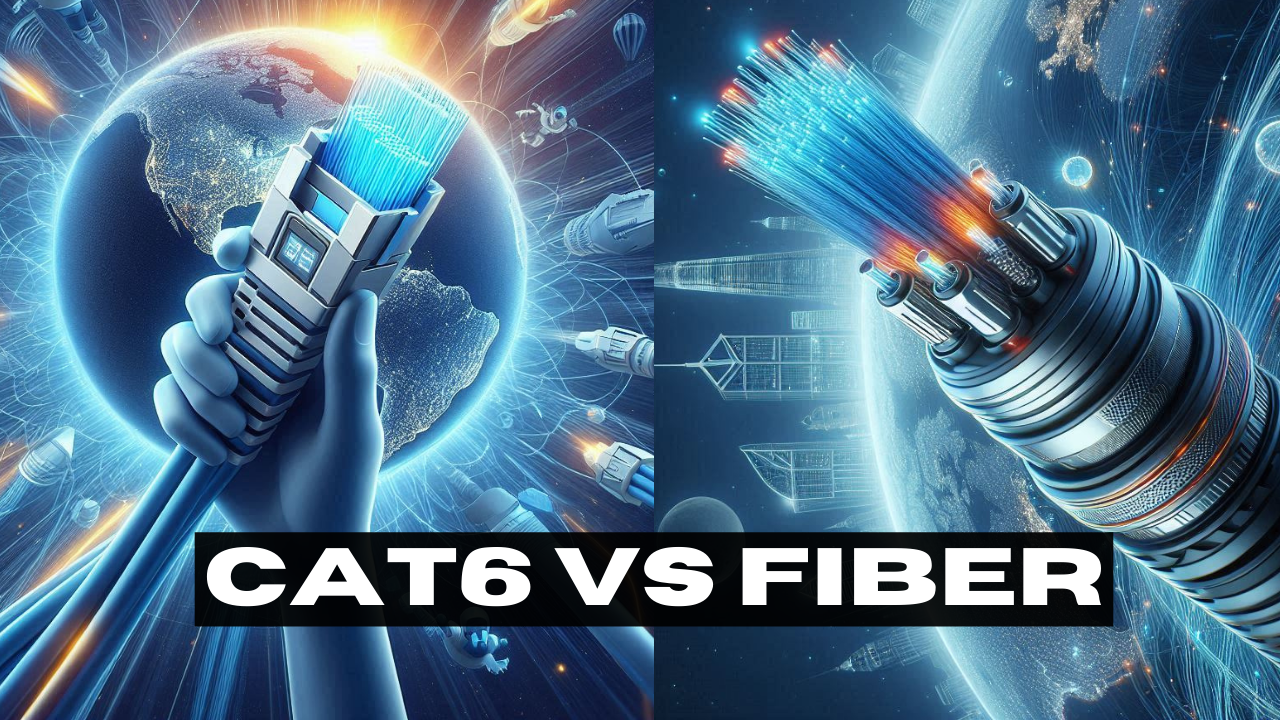When setting up a network infrastructure, one of the most important decisions is choosing between Cat6 cables and fiber optic cables. Both options offer distinct advantages, but the right choice depends on your specific needs, such as data transfer speed, distance, cost, and the environment. In this guide, we’ll compare Cat6 vs fiber optic cables and provide insights on how to make an informed choice for your network.
What Are Cat6 Cables?
Cat6 cables (Category 6) are twisted pair copper cables designed for Ethernet and other networking purposes. They are widely used due to their cost-effectiveness and ease of installation. Cat6 cables can support high-speed data transfer rates of up to 10 Gbps over distances up to 100 meters. However, they can be vulnerable to electromagnetic interference (EMI), which may impact performance in environments with high electrical noise.
Key Features of Cat6 Cables:
- Data Transmission Speed: Up to 10 Gbps
- Transmission Distance: Effective up to 100 meters (328 feet)
- Cost: Affordable and cost-effective
- Installation: Simple and user-friendly installation process
- Interference: Prone to electromagnetic interference (EMI)
What Are Fiber Optic Cables?
Fiber optic cables are high-performance cables that transmit data as light pulses through glass or plastic fibers. They offer significantly faster data transfer speeds and can cover much longer distances compared to Cat6 cables. Fiber optics are also immune to electromagnetic interference, making them ideal for environments where EMI could be a concern, such as industrial settings or areas with high electrical activity. However, fiber optic cables are more expensive and require specialized tools and expertise for installation.
Key Features of Fiber Optic Cables:
- Data Transmission Speed: Up to 40 Gbps or more
- Transmission Distance: Can cover distances of up to 180 kilometers (112 miles) or more
- Cost: Higher initial investment than Cat6 cables
- Installation: Requires specialized tools, training, and expertise
- Interference: Immune to electromagnetic interference (EMI)
Cat6 vs Fiber Optic Cables: How to Choose?
When deciding between Cat6 and fiber optic cables, it’s important to consider several factors, such as transmission distance, speed requirements, budget, and installation complexity.
1. Transmission Distance
- Fiber optic cables are ideal for long-distance data transmission. They can cover distances up to 180 kilometers without signal degradation, making them suitable for large-scale networks and data centers.
- Cat6 cables, on the other hand, are limited to approximately 100 meters (328 feet) for optimal performance.
2. Data Transfer Speed
- Fiber optics outperform Cat6 cables in terms of data transfer speed, offering speeds of up to 40 Gbps or more. This makes them a better choice for high-speed networks, heavy data traffic, and applications like cloud computing, video streaming, and large data transfers.
- Cat6 cables support speeds up to 10 Gbps, which is sufficient for most residential or small office applications but may fall short in environments that require high bandwidth.
3. Cost Considerations
- Cat6 cables are generally more affordable, making them a popular choice for those on a budget or for smaller-scale networks. Their lower upfront costs also make them suitable for businesses and residential setups.
- Fiber optic cables come with a higher initial investment, not only for the cables themselves but also for installation costs, specialized tools, and expert labor. However, the long-term benefits, such as higher performance and future-proofing, may justify the extra cost in certain scenarios.
4. Environmental Factors (EMI)
- Fiber optic cables are immune to electromagnetic interference (EMI), making them the best choice in environments where electrical noise could disrupt network performance. They are commonly used in industrial environments, large-scale data centers, and settings with high electromagnetic interference.
- Cat6 cables are more susceptible to EMI and may suffer from signal degradation in noisy environments. This can be mitigated with shielding (e.g., shielded Cat6 cables), but fiber optic remains the better option for interference-free performance.
5. Ease of Installation
- Cat6 cables are easier to install, requiring no specialized equipment or skills. This makes them an ideal choice for DIY projects or installations in smaller environments.
- Fiber optic cables require specialized training and equipment for installation. The complexity of fiber optic cable installation increases both the time and cost of deployment.
Also Read: What is FTTH in Broadband? A Complete Guide to Fiber to the Home Technology
Fiber Optic vs Cat6: Which One Should You Choose?
The decision between Cat6 and fiber optic cables depends on the following:
- Use Case: If you need high-speed internet or plan to run a network over long distances, fiber optic cables are the better choice due to their speed and long-range capabilities.
- Budget: For smaller projects or those on a tight budget, Cat6 cables are a more cost-effective option without compromising on speed for most typical networking needs.
- Future-Proofing: If you are building a network with future demands in mind, fiber optics offer scalability and speed that can meet the growing needs of high-traffic applications.
- Environment: In areas with significant electromagnetic interference (EMI) or outdoor installations, fiber optic cables are the preferred option due to their immunity to interference.
Conclusion: Cat6 vs Fiber Optic Cables
Both Cat6 cables and fiber optic cables have their advantages, but the right choice ultimately depends on your specific needs. If you prioritize cost and ease of installation for shorter distances, Cat6 cables may be the best fit. However, if you need higher speeds, greater distances, and an interference-free environment, fiber optic cables are the clear winner.
By evaluating your network speed, distance requirements, budget, and installation needs, you can make the best decision for your networking setup. Whether you’re upgrading an existing network or setting up a new one, understanding the differences between Cat6 vs fiber optic cables will ensure you choose the right solution for optimal performance.
